Ancient Egypt
Beliefs
Process of mummification
Embalming The Body
First, his body is taken to the tent known as 'ibu' or the 'place of purification'. There the embalmers wash his body with good-smelling palm wine and rinse it with water from the Nile.
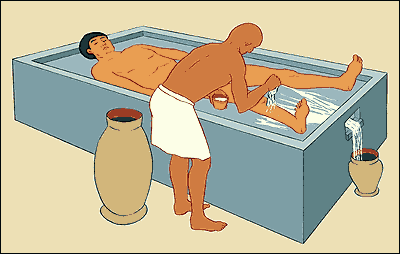
ne of the embalmer's men makes a cut in the left side of the body and removes many of the internal organs. It is important to remove these because they are the first part of the body to decompose.
The liver, lungs, stomach and intestines are washed and packed in natron which will dry them out. The heart is not taken out of the body because it is the centre of intelligence and feeling and the man will need it in the afterlife.
A long hook is used to smash the brain and pull it out through the nose.
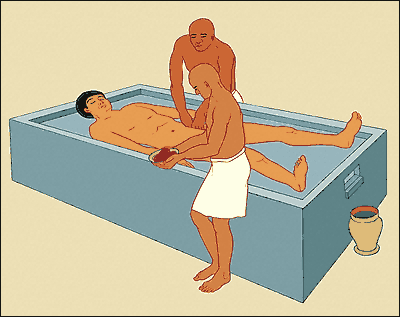
The body is now covered and stuffed with natron which will dry it out. All of the fluids, and rags from the embalming process will be saved and buried along with the body.
After forty days the body is washed again with water from the Nile. Then it is covered with oils to help the skin stay elastic.
The dehydrated internal organs are wrapped in linen and returned to the body. The body is stuffed with dry materials such as sawdust, leaves and linen so that it looks lifelike.
Finally the body is covered again with good-smelling oils. It is now ready to be wrapped in linen.
In the past, when the internal organs were removed from a body they were placed in hollow canopic jars.
Over many years the embalming practices changed and embalmers began returning internal organs to bodies after the organs had been dried in natron. However, solid wood or stone canopic jars were still buried with the mummy to symbolically protect the internal organs.
Imsety

Imsety the human-headed god looks after the liver.
Duamutef

Duamutef the jackal-headed god looks after the stomach
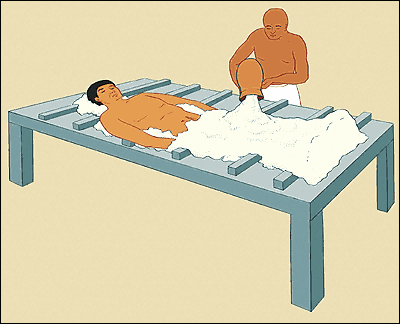
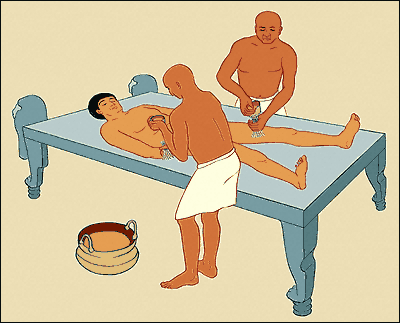
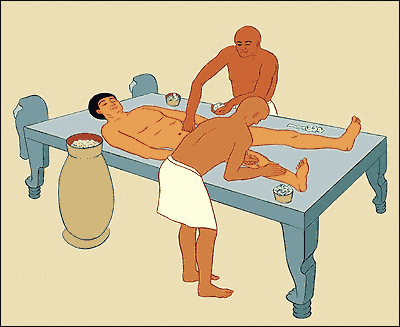
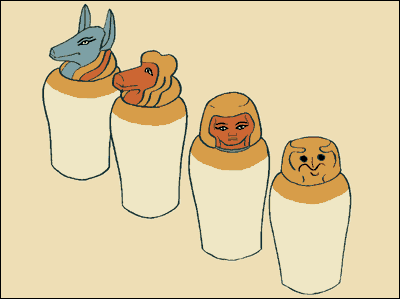
Hapy

Hapy the baboon-headed god looks after the lungs.
Qebehsenuef

Imsety the human-headed god looks after the liver.
Wrapping The Body
First the head and neck are wrapped with strips of fine linen. Then the fingers and the toes are individually wrapped.
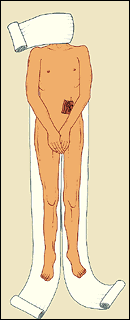
The arms and legs are wrapped separately. Between the layers of wrapping, the embalmers place amulets to protect the body in its journey through the underworld.
A priest reads spells out loud while the mummy is being wrapped. These spells will help ward off evil spirits and help the deceased make the journey to the afterlife.
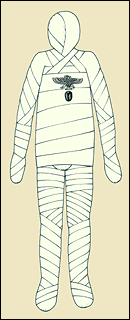
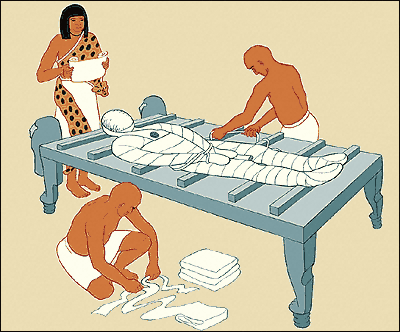
The arms and legs are tied together. A papyrus scroll with spells from the Book of the Dead is placed between the wrapped hands.
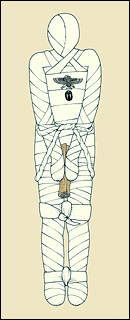
More linen strips are wrapped around the body. At every layer, the bandages are painted with liquid resin that helps to glue the bandages together.

A cloth is wrapped around the body and a picture of the god Osiris is painted on its surface.

Finally, a large cloth is wrapped around the entire mummy. It is attached with strips of linen that run from the top to the bottom of the mummy, and around its middle.
A board of painted wood is placed on top of the mummy before the mummy is lowered into its coffin. The first coffin is then put inside a second coffin.
The funeral is held for the deceased and his family mourns his death.
A ritual called the 'Opening of the Mouth' is performed, allowing the deceased to eat and drink again.
Finally, the body and its coffins are placed inside a large stone sarcophagus in the tomb. Furniture, clothing, valuable objects, food and drink are arranged in the tomb for the deceased.
Now his body is ready for its journey through the underworld. There his heart will be judged by his good deeds on earth. If his heart is found to be pure he will be sent to live for all eternity in the beautiful 'Field of Reeds'.
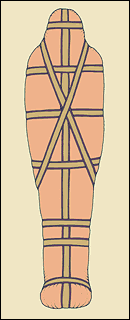


Egyptian Gods & Goddesses
Sekhmet
Sekhmet (Sakhmet) is one of the oldest known Egyptian deities. Her name is derived from the Egyptian word "Sekhem" (which means "power" or "might") and is often translated as the "Powerful One" or "She who is Powerful". She is depicted as a lion-headed woman, sometimes with the addition of a sun disc on her head. Her seated statues show her holding the ankh of life, but when she is shown striding or standing she usually holds a sceptre formed from papyrus (the symbol of northern or Lower Egypt) suggesting that she was associated primarily with the north. However, some scholars argue that the deity was introduced from Sudan (South of Egypt) where lions are more plentiful.

Ra
Ra (Re) was the primary name of the sun god of Ancient Egypt. He was often considered to be the King of the Gods and thus the patron of the pharaoh and one of the central gods of the Egyptian pantheon. He was also described as the creator of everything. Ra was so powerful and popular and his worship was so enduring that some modern commentators have argued that the Egyptian religion was in fact a form of veiled monotheism with Ra as the one god. This seems to be somewhat of an overstatement, but underlines his primary position within religious texts throughout Egyptian history.

Horus
Horus was considered to be a celestial falcon, and so his name could be a specific reference to the flight of the falcon, but could also be seen as a more general solar reference. It is thought that the worship of Horus was brought into Egypt during the predynastic period.
He seems to have begun as a god of war and a sky god who was married to Hathor, but soon became considered as the opponent of Set, the son of Ra, and later the son of Osiris.

Pyraimid Diagram

Belifs Questions
Questions I ask the Ancient Egyptians about belifs:
Q:
How does religon influence every aspect of your life?
A:
The gods involvement in our daily life is critical to existence itself, since the gods are responsible for the maintenance of our world. The march of the sun across the sky, the flow of the river Nile, the growth of food and all other aspects of life is run by the gods.
Q:
What are 3-5 characteristics of your religon/belief system?
A:
We believe in many gods and prepare for the afterlife. Also we believe that the creator of everything is Ra.
Q:
Why/how are pyramids built, and how does it connect to your religon/belief system?
A:
Pyramids were built for pharaoh's tombs because they were concidered as gods. To build pyramids we use quarried stone placed by manual labor.
hYMN TO OSIRIS
This is the first paragraph:
"Homage to thee, Osiris, Lord of eternity, King of the Gods, whose names are manifold, whose forms are holy, thou being of hidden form in the temples, whose Ka is holy. Thou art the governor of Tattu (Busiris), and also the mighty one in Sekhem (Letopolis). Thou art the Lord to whom praises are ascribed in the nome of Ati, thou art the Prince of divine food in Anu. Thou art the Lord who is commemorated in Maati, the Hidden Soul, the Lord of Qerrt (Elephantine), the Ruler supreme in White Wall (Memphis). Thou art the Soul of Ra, his own body, and hast thy place of rest in Henensu (Herakleopolis). Thou art the beneficent one, and art praised in Nart. Thou makest thy soul to be raised up. Thou art the Lord of the Great House in Khemenu (Hermopolis). Thou art the mighty one of victories in Shas-hetep, the Lord of eternity, the Governor of Abydos. The path of his throne is in Ta-tcheser (a part of Abydos). Thy name is established in the mouths of men. Thou art the substance of Two Lands (Egypt). Thou art Tem, the feeder of Kau (Doubles), the Governor of the Companies of the gods. Thou art the beneficent Spirit among the spirits. The god of the Celestial Ocean (Nu) draweth from thee his waters. Thou sendest forth the north wind at eventide, and breath from thy nostrils to the satisfaction of thy heart. Thy heart reneweth its youth, thou producest the.... The stars in the celestial heights are obedient unto thee, and the great doors of the sky open themselves before thee. Thou art he to whom praises are ascribed in the southern heaven, and thanks are given for thee in the northern heaven. The imperishable stars are under thy supervision, and the stars which never set are thy thrones. Offerings appear before thee at the decree of Keb. The Companies of the Gods praise thee, and the gods of the Tuat (Other World) smell the earth in paying homage to thee. The uttermost parts of the earth bow before thee, and the limits of the skies entreat thee with supplications when they see thee. The holy ones are overcome before thee, and all Egypt offereth thanksgiving unto thee when it meeteth Thy Majesty. Thou art a shining Spirit-Body, the governor of Spirit-Bodies; permanent is thy rank, established is thy rule. Thou art the well-doing Sekhem (Power) of the Company of the Gods, gracious is thy face, and beloved by him that seeth it. Thy fear is set in all the lands by reason of thy perfect love, and they cry out to thy name making it the first of names, and all people make offerings to thee. Thou art the lord who art commemorated in heaven and upon earth. Many are the cries which are made to thee at the Uak festival, and with one heart and voice Egypt raiseth cries of joy to thee."